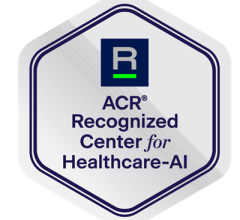
Image courtesy of the American College of Radiology
July 8, 2022 — The Society of Cardiovascular Computed Tomography (SCCT) has released a new expert consensus document on Coronary Artery Disease – Reporting and Data System (CAD-RADS) in collaboration with the American College of Cardiology (ACC), the American College of Radiology (ACR) and the North America Society of Cardiovascular Imaging (NASCI).
The expert consensus document 2022 Coronary Artery Disease – Reporting and Data System, or CAD-RADS 2.0, expands on the first version, which was created in 2016 to standardize reporting system for patients undergoing coronary CT angiography (CCTA) and to guide possible next steps in patient management.
The collaboration was led by Ricardo Cury, MD, MBA, FACC, FACR, FAHA, MSCCT and Ron Blankstein, MD, FACC, MSCCT, FASPC with a goal to update and improve the initial 2016 reporting system for CCTA by incorporating the latest technical developments as well as recent clinical trials and guidelines in cardiac computed tomography (CCT).
“Even though coronary CTA can be a very useful test when performed on the right patient population, the test itself does not change outcomes. Rather, it is how clinicians act on the test results that ultimately makes a difference. For this reason, it is essential to provide referring clinicians with patient management recommendations which are now part of the CAD-RADS 2.0 statement,” explains Dr. Blankstein.
Published in the Journal of Cardiovascular Computed Tomography (JCCT), the updated classification will follow an established framework of stenosis, plaque burden and modifiers, which will include assessment of CT fractional-flow-reserve (CT-FFR) or myocardial CT perfusion (CTP), when performed.
One key update provided in the CAD-RADS 2.0 statement is that plaque burden should be estimated whenever present. This can be accomplished using either an evaluation of the amount of coronary artery calcium (CAC), if performed, segment involvement score (SIS), a visual assessment or total plaque burden quantification, when available and validated. Based on these methods, the overall amount of plaque (P) descriptor ranges from P1 to P4 (mild, moderate, severe, extensive) to denote increasing categories of plaque burden.
Two new modifiers were also added: modifier I (ischemia) indicating that an ischemia test with CT has been performed (either CT-FFR or stress CTP) and if the result was positive (+), negative (-) or borderline (+/-); and modifier E (exceptions) to denote the presence of non-atherosclerotic narrowing of the coronary arteries.
Along with significant updates, some consistencies remain from the original guideline and were emphasized in the 2.0 version, including the stenosis severity classification remains the same, ranging from CAD-RADS 0 for absence of any plaque or stenosis to CAD-RADS 5 indicating the presence of at least one 100% occluded vessel.
The authors also stressed that CAD-RADS classification should always be interpreted together with the impression found in the report.
"I am pleased and humbled to have worked with an expert group of leaders in the field of Cardiology, Radiology and Cardiac Imaging to improve and expand the updated CAD-RADS 2.0 document considering recent clinical trials, new guidelines and increasing data supporting the prognostic relevance of coronary plaque burden and physiologic assessment by cardiac CT," says Dr. Cury.
He stressed that, because of this important update, CAD-RADS will continue to provide a framework of standardization that may benefit education, research, peer-review, artificial intelligence development, clinical trial design, population health and quality assurance with the ultimate goal of improving patient care.
For more information: www.scct.org
Related SCCT Key Trends and New Technology Content:
Low-attenuation Coronary Plaque Burden May Become Next Big Cardiac Risk Assessment
Top 9 Cardiovascular CT Studies in Past Year
VIDEO: Increased Use of Cardiac CT During the COVID-19 Pandemic
VIDEO: Key Cardiac CT Papers Presented at SCCT 2020
VIDEO: Photon Counting Detectors Will be the Next Major Advance in Computed Tomography
VIDEO: Artificial Intelligence to Automate CT Calcium Scoring and Radiomics


 August 09, 2024
August 09, 2024 








